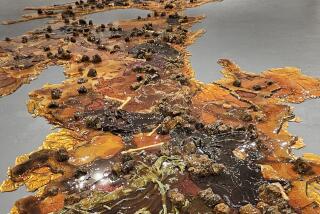Understanding the Riots Part 4 : Seeing Ourselves : LOS ANGELES : The volcano is dormant for the moment.
I am standing at Pico and Berendo, one of my old haunts. Ten years ago, a couple of blocks south of this intersection, I used to rehearse with my rock ‘n’ roll band in a not-so-soundproof room at our drummer’s house, gaining both enmity and friendship among our Latino and Asian neighbors. Venerable spell-casting matrons sold incense and herbs at the botanicas up and down Pico. At my favorite pupuseria , I shared many a cold Salvadoran beer with bohemian friends. And the old Trotskyite bookstore, the Pathfinder, was a provisional hangout during my years of ideological searching.
I am standing at Pico and Berendo, at about 2 in the afternoon on Thursday, April 30, 1992. I cannot walk south on Berendo past my old rehearsal space because there’s chaos in that direction: An Asian driver slams on the brakes, jumps out of his car and trains a pistol on a Latino man in the car behind him. The botanicas were shuttered hours ago as the gods of rage descended on Pico-Union. My favorite pupuseria is in danger of going up in flames, the convenience store next door having been looted and torched. And the Pathfinder? Its black and red sign is melting, coils of black smoke leaping skyward as the texts of revolution burn.
We stand on the corner, the youngsters and the grandparents, the mothers cradling babies, the homeless and the drunks. Most of us stare in shock as the looting begins in earnest. The scene is straight out of the civil war in El Salvador--and hadn’t most of the residents of this barrio come north precisely to escape that horror?
More and more people join in, prying the security gates back from the windows of the liquor stores, mini markets, pawn shops and clothing stores. Mothers and grandmothers collect food, not out of greed now, but out of necessity: If the entire barrio is destroyed, how will they feed their families? Whatever justifiable rage there was about the King verdict, about the years of poverty and frustration in the inner city, has doubled back upon itself. The barrio is burning itself down.
Some of that rage resides in me. It surfaces now and then, like when I am the only brown-skinned person at a party or at a fancy restaurant. I react to real or imagined slights against my culture. A volcano of anger erupts, and the offensive always cuts both ways. Even as I am laying waste to the “enemy’s” camp, my chest tightens. I want to crawl out of my skin. I hate myself as much as I hate the other.
Every year during my elementary education here in Los Angeles, I was presented with a school district survey asking me to identify myself as “white,” “black,” “Asian,” “Mexican” or “other.” I always preferred the latter; I didn’t fit into any of the categories, since I was both Mexican and Salvadoran through my parents. Besides, back then I fancied myself “Spanish,” thus freeing me from the historical dungeon of being a “dirty Mexican.” In other words, I tried to become the other so that the other wouldn’t view me as the other. Remnants of this painful self-loathing remain embedded in my psyche today.
The volcano erupted many times during the riots. It spewed forth epithets against my managing editor at the L.A. Weekly as he did his job (pressured me for copy). My managing editor is white. He is perhaps the most “culturally sensitive” member of our staff. But that didn’t matter in that moment--the volcano does not distinguish between the “good” and the “bad.”
Perhaps the most important lesson to be learned here is that the violence was a black thing, and a Latino thing, and a white and Asian thing. It was our thing. The riots showed us--and the rest of the world that lapped up L.A.’s silly “multicultural” boosterism--how inexorably our destinies as ethnic groups are linked, as well as how divided we are. What happened on our streets cannot be explained simply as a “race war.” It is race and class, it is hatred of the other and self-hatred as well.
I want to sound an optimistic note, but I cannot. The rage remains, in the individual and in the collective. Its child, paranoia, now affects relationships among all of L.A.’s ethnic groups. How can we regain a sense of trust? The volcano is there, dormant for the moment, but it will erupt again and again, until cultural attitudes on all sides, as well as our economic relationships, are radically transformed.
More to Read
Sign up for Essential California
The most important California stories and recommendations in your inbox every morning.
You may occasionally receive promotional content from the Los Angeles Times.










